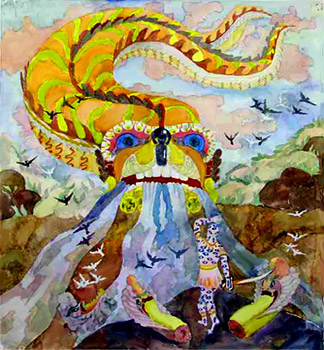 Vritra is also known as Ahi in the Vedas. He appears as a dragon who blocks the course of the rivers and is killed by Indra. As per the Rig Veda, Vritra kept the waters of the world confined until he was killed by Indra. Lord Indra destroyed all the ninety-nine fortresses of Vritra before liberating the rivers. The fight began soon after Indra was born, and he had drunk a large volume of Soma at Tvashtri`s house in order to empower himself before facing Vritra. Tvashtri disguised as thunderbolt or Vajrayudha for Indra, and Vishnu made space for the battle by taking the three great strides. During the battle Vritra broke Indra`s two jaws however was thrown down by the latter.
Vritra is also known as Ahi in the Vedas. He appears as a dragon who blocks the course of the rivers and is killed by Indra. As per the Rig Veda, Vritra kept the waters of the world confined until he was killed by Indra. Lord Indra destroyed all the ninety-nine fortresses of Vritra before liberating the rivers. The fight began soon after Indra was born, and he had drunk a large volume of Soma at Tvashtri`s house in order to empower himself before facing Vritra. Tvashtri disguised as thunderbolt or Vajrayudha for Indra, and Vishnu made space for the battle by taking the three great strides. During the battle Vritra broke Indra`s two jaws however was thrown down by the latter.
After this Indra was known as Vritrahan "slayer of Vritra" and also as "slayer of the first-born of dragons". Danu, Vritra`s mother was attacked and defeated by Indra with his thunderbolt.
Versions in Puranas
According to Puranic myths Vritra was created by Tvashtri in order to take revenge of his son`s killing by Indra. Vritra won the battle and swallowed Indra. However other gods forced him to vomit Indra out. The battle continued and Indra was forced to flee. Vishnu created a respite, with Indra swearing that he would not attack Vritra with anything that is made of metal, wood, stone nor anything that was dry or wet, or during the day or the night. Indra used the foam from the waves of the ocean to kill him at twilight.
In some Hindu texts Vritra was considered as a devotee of Lord Vishnu who was killed due to his failure to live piously. Vritra was a Brahmin who became the head of the Asuras. He renounced his dharma to do well unto others and turned to violence thereby battling with the Gods. He gained immense power. Lord Indra approached Lord Vishnu for help. He told them that Vritra could not be destroyed by ordinary means and a weapon made of bones of a sage could kill him. Vishnu directed them to approach the sage Dadichi. He gladly gave up his bones for the cause of the good. The Devas crafted the Vajrayudha from them. The battle between the Devas and Vritra lasted for 360 days and he died eventually.




















